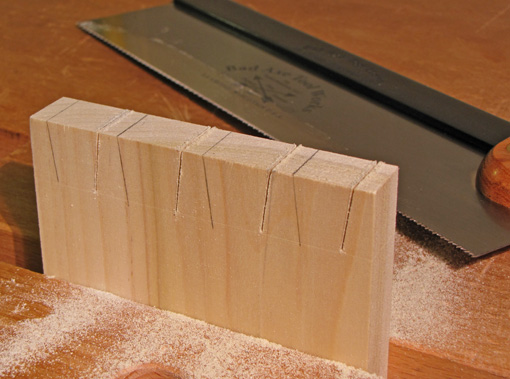
Tip #5: Be assertive “to the line.” Timid does not work.
To determine if your saw strokes are following the line, you have to observe sufficient incremental progress to close the loop of intent and result. In other words, you have to see how it’s going.
An ineffective strategy is to go very slow, with the supposition that although such extreme care is time consuming, at least things won’t go wrong. Yet if each stroke is barely consequential, such as when using a saw with too many teeth per inch for the job, it is difficult to know how it’s going and how to adjust. Much like learning to ride a bicycle, being overcautious will prevent you from ever learning. At some point, you have to let it flow, even if sometimes you will fall.
The answer is not a dovetail saw with 32 tpi. This is not to suggest being reckless or careless, but appropriately confident.
A similar problem is taking too much clearance from the line. This leads to excessive clean up maneuvers, creating more opportunities for things to go wrong and to lose direction. One-sided tolerance, an awareness of directional errors (discussed in another post), is one of the key concepts in craftsmanship, but it should not be misconstrued as an excuse for timidly missing by a mile.
When sawing, the visual and physical senses continually inform each other. As you see success developing, your movements gain assurance. The physical sense takes precedence as the cut proceeds, and as assurance builds, speed can increase as an easy flow develops. [In the cuts above, I did the one on the right first, not quite fully assertive, then went at it and split the line nicely on the other three, picking up speed.]
There is a solution to all of this: practice! And if you miss, get another piece of wood. I’ve had a lot of practice at that! Truly, we’re all students.
Happy sawing!


I’ve enjoyed your series on sawing to a line, and the links to equally stimulating blog posts you’ve incorporated. I’ve certainly got a lot to learn in this area!
Thanks, Rob
yes, this whole series has been really helpful. I have to admit, I totally had no idea what “splitting the line” meant!
Thanks Rob and Aaron, I’m glad the series was helpful. I too have a lot to learn.
Rob
By the way readers, that IS a Bad Axe dovetail saw that you see in the photo. More to come on that later but, in short, I love it. Check out Mark Harrell’s work at:
http://www.badaxetoolworks.com/10-inch-dovetail-back-saw.html
Rob
I sure wish I could go back in time and read this blog post several years back when I first starting cutting dovetails by hand. It took me a long time to figure out that going slow was actually my worst enemy. Once I gained confidence and starting just sawing to a straight line my results improved quite a bit. Great advice Rob.
Awesome article, Rob! And thanks for the plug. There are days where I feel more like a professional featherboard-maker than a sawmaker, and the techniques you’ve written about are absolutely spot-on.
Thanks for the series. Clears up alot of questions. Since I have been leaving the line on joinery (but being right on it), the joints close up much more neatly.
Good to see we have similar taste in DT saws. Mark is a wizard.
–Steve.